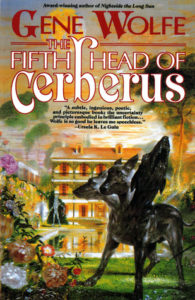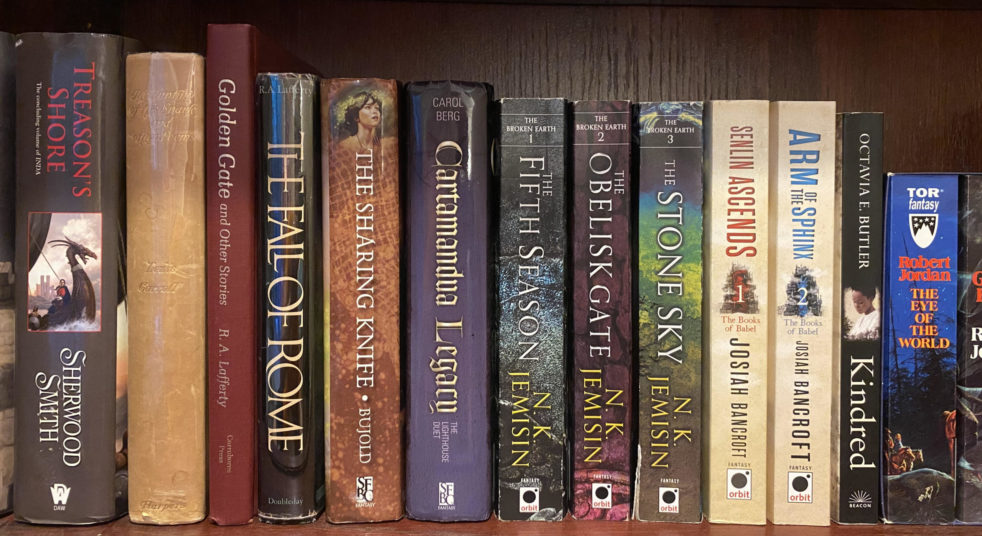
Being a big fan of R.A. Lafferty, it’s hard not to hear lots of recommendations for the other Catholic sci-fi writer known for his creativity, symbolism, and prose style that’s considered by many fans to be an all-time great. And yet, perhaps intimidated a bit by his reputation for unreliable narrators and confusing plots, it took me an embarrassingly long time to actually try Gene Wolfe. I have now rectified this error by reading The Fifth Head of Cerberus.
The novel The Fifth Head of Cerberus actually consists of the novella “The Fifth Head of Cerberus,” combined with two other novellas set in the same world: “‘A Story’ by John V. Marsch” and “V.R.T.” The first could easily be read as a standalone novella and tells of an unnamed boy growing up in a brothel on the planet of Sainte Croix, with a mechanical caretaker and a father obsessed with genetic experiments. The second takes place on the neighboring planet of Sainte Anne and could perhaps also be read alone, telling a disorienting and magical story of the aboriginal population. The third features an officer combing through a disorganized collection of interviews and diary entries, trying to piece together information about a particular prisoner. This piece provides a bridge between the first two, with countless references that make sense only in context of the other stories.
So is it worth the hype? Worth the read? It’s complicated. I feel comfortable saying that there is some excellent storytelling within The Fifth Head of Cerberus, but it doesn’t come neatly together into a satisfying whole. It’s very clearly not supposed to, and for some readers, finding the story within the story will be part of the fun. For other readers, it may make for a slog. For me, it’s probably somewhere in between.
I was surprised to find that even the opening titular novella doesn’t really end with a big climax. To be clear, there are events—mostly centering around the lead’s fraught relationship with his aloof scientist father—that build throughout the story and come to a head in the latter stages, but Wolfe doesn’t leave the reader with the feeling that these big events were the point of the story. The narrative meanders through academic studies, adolescent friendships, and dream sequences, with reflections on automata, slavery, and the history of the aboriginal peoples, and many of those elements have as much claim to the spotlight as does the main story.
But even with the unsettling lack of closure, I found a lot to like in “The Fifth Head of Cerberus.” I can’t say I necessarily see how all the dream sequences fit into the bigger picture, but the prose was gripping throughout—with a couple truly outstanding passages, particularly in reflections on personhood—and once I recalibrated my narrative expectations, the surface story worked very well as something of a dark coming-of-age.
Unfortunately, I didn’t have the same success with “‘A Story’ by John V. Marsch.” Again, the surface story is fairly comprehensible, as an adventure spotlighting the native peoples of Sainte Croix’s near neighbor Sainte Anne. But I don’t have quite the fondness for adventure stories that many readers do, and I often found the native mythologies that were so deeply intertwined with the main narrative to be difficult to grasp. The prose didn’t drop off, and it wasn’t long enough to leave me irrevocably stuck, but I found it generally slow going.
“V.R.T.” was also slow going, but for entirely different and much more entertaining reasons. It’s explicitly set up as a puzzle, with frequent jumps between snippets of decontextualized fragments of diaries or interviews. And, while it may be hard to read puzzle stories quickly, it’s fun trying to figure out where the pieces go, and having read the first two novellas provides enough reference points to make the third generally comprehensible, even if some of the details remain opaque.
Overall, The Fifth Head of Cerberus is fascinating and compelling work, though some elements work better than others. The title novella admirably serves double-duty as a standalone piece and as lead-in to the other two, with the nameless lead’s arc generally put to bed at the end of the opening piece, but with so many other elements of the world primed for further exploration in the following two. In particular, the opening novella periodically gestures at the mysterious fate of the aboriginal population, while the second and third take it up as their main themes.
I can’t recommend The Fifth Head of Cerberus to readers who desire traditional narrative structures, or who shy away from attempts to place stray remarks in their proper context, but for readers who enjoy more complicated narratives and don’t mind some darkness, it’s a real winner. For my own part, I found the second novella less interesting and more difficult to appreciate, which perhaps keeps me from getting the most out of the whole, even as I understand the vital role played by all three sections. But between the dark coming-of-age, the fascinating puzzle, and the reflections on colonialism and the fate of the aboriginal races, there’s a whole lot to appreciate here. And I have no doubt that it’s even better upon reread.
Recommended if you like: prose, puzzles, philosophical sci-fi.
Can I use it for Bingo? It’s hard mode for Mundane Jobs and also has a Coastal Setting and Features Robots. And while it isn’t magical realism, it’s hard not to say it qualifies as Literary SFF.
Overall rating: 16 of Tar Vol’s 20. Four stars on Goodreads.
